A Metamaterials-Based Absorber Used for Switch Applications with Dynamically Variable Bandwidth in Terahertz Regime
Abstract
:1. Introduction
2. Materials and Methods
3. Results and Discussion
3.1. Broadband Absorber Used for Switch Applications
3.2. Multiple Broadband Absorption Modes
4. Conclusions
Author Contributions
Funding
Institutional Review Board Statement
Informed Consent Statement
Data Availability Statement
Conflicts of Interest
References
- Willie, J.; Richard, D. Imaging with metamaterials. Nat. Rev. Phys. 2021, 4, 85–100. [Google Scholar]
- Krasnok, A. Metalenses go atomically thick and tunable. Nat. Photon. 2020, 14, 409–410. [Google Scholar] [CrossRef]
- Han, T.; Bai, X.; Thong, J.T.L.; Li, B.; Qiu, C.-W. Full control and manipulation of heat signatures: Cloaking, camouflage and thermal metamaterials. Adv. Mater. 2014, 26, 1731–1734. [Google Scholar] [CrossRef] [PubMed]
- Iwaszczuk, K.; Strikwerda, A.C.; Fan, K.; Zhang, X.; Averitt, R.D.; Jepsen, P.U. Flexible metamaterial absorbers for stealth applications at terahertz frequencies. Opt Express 2012, 20, 635–643. [Google Scholar] [CrossRef] [PubMed]
- Zhang, Y.; Li, T.; Zeng, B.; Zhang, H.; Lv, H.; Huang, X.; Zhang, W.; Azad, A.K. A graphene based tunable terahertz sensor with double Fano resonances. Nanoscale 2015, 7, 12682–12688. [Google Scholar] [CrossRef] [PubMed]
- Faruk, A.; Sabah, C. Absorber and sensor applications of complimentary H-shaped fishnet metamaterial for sub-terahertz frequency region. Optik 2019, 177, 64–70. [Google Scholar] [CrossRef]
- Nikitkina, A.I.; Bikmulina, P.; Gafarova, E.R.; Kosheleva, N.V.; Efremov, Y.M.; Bezrukov, E.A.; Butnaru, D.V.; Dolganova, I.N.; Chernomyrdin, N.V.; Cherkasova, O.P.; et al. Terahertz radiation and the skin: A review. J. Biomed. Opt. 2021, 26, 043005. [Google Scholar] [CrossRef]
- Zeng, Q.M.; Huang, Y.; Zhong, S.C.; Lin, T.L.; Zhong, Y.J.; Zhang, Z.H.; Yu, Y.J.; Peng, Z.K. Multiple resonances induced terahertz broadband filtering in a bilayer metamaterial. Front. Phys. 2022, 10, 857422. [Google Scholar] [CrossRef]
- Chen, Y.L.; Li, J.Q.; He, C.P.; Qin, J.S.; Chen, X.H.; Li, S.L. Enhancement of high transmittance and broad bandwidth terahertz metamaterial filter. Opt. Mater. 2021, 115, 111029. [Google Scholar] [CrossRef]
- Landy, N.I.; Sajuyigbe, S.; Mock, J.J. Perfect Metamaterial Absorber. Phys. Rev. Lett. 2008, 100, 207402. [Google Scholar] [CrossRef]
- Korani, N.; Danaie, M. A plasmonic terahertz perfect absorber based on L-shaped graphene patches and gold rods. Appl. Phys. A 2023, 129, 806. [Google Scholar] [CrossRef]
- Grebenchukov, A.; Masyukov, M.; Zaitsev, A.; Khodzitsky, M. Asymmetric graphene metamaterial for narrowband terahertz modulation. Opt. Commun. 2020, 476, 126299. [Google Scholar] [CrossRef]
- Wang, Q.; Liu, Y.K.; Wang, G.C.; Jiang, W.X.; Cui, T.J. Tunable triple-band millimeter-wave absorbing metasurface based on nematic liquid crystal. AIP Adv. 2022, 12, 015127. [Google Scholar] [CrossRef]
- Xu, K.D.; Li, J.; Zhang, A.; Chen, Q. Tunable multi-band terahertz absorber using a single-layer square graphene ring structure with T-shaped graphene strips. Opt. Express 2020, 28, 11482–11492. [Google Scholar] [CrossRef] [PubMed]
- Liu, K.; Tu, Z.; Tang, X.; Li, Z.; Chen, F.; Yang, W.; Wang, B. High-sensitivity triple-band absorber based on graphene rectangular split ring resonator and cross-structure. Plasmonics 2024, 19, 1291–1302. [Google Scholar] [CrossRef]
- Liu, Y.; Huang, R.; Ouyang, Z.B. Terahertz absorber with dynamically switchable dual-broadband based on a hybrid metamaterial with vanadium dioxide and graphene. Opt. Express 2021, 29, 20839–20850. [Google Scholar] [CrossRef]
- James, G.; Yong, M.; Shimul, S. Polarization insensitive, broadband terahertz metamaterial absorber. Opt. Lett. 2011, 36, 3476. [Google Scholar]
- Zhao, X.G.; Wang, Y.; Schalch, J. Optically Modulated Ultra-Broadband All-Silicon Metamaterial Terahertz Absorbers. ACS Photonics 2019, 6, 830–837. [Google Scholar] [CrossRef]
- Chowdhury, M.Z.; Shahjalal, M.; Ahmed, S.; Jang, Y.M. 6G wireless communication systems: Applications, requirements, technologies, challenges, and research directions. IEEE Open, J. Commun. Soc. 2020, 1, 957–975. [Google Scholar] [CrossRef]
- Li, J.; Zhang, Y.; Li, J.; Yan, X.; Liang, L.; Zhang, Z.; Huang, J.; Li, J.; Yang, Y.; Yao, J.J.N. Amplitude modulation of anomalously reflected terahertz beams using all-optical active Pancharatnam–Berry coding metasurfaces. Nanoscale 2019, 11, 5746–5753. [Google Scholar] [CrossRef]
- Chen, A.; Song, Z. Tunable isotropic absorber with phase change material VO2. IEEE Trans. Nanotechnol. 2020, 19, 197–200. [Google Scholar] [CrossRef]
- Pitchappa, P.; Kumar, A.; Prakash, S.; Jani, H.; Venkatesan, T.; Singh, R. Chalcogenide phase change material for active terahertz photonics. Adv. Mater. 2019, 31, 1808157. [Google Scholar] [CrossRef] [PubMed]
- Wang, L.; Ge, S.; Hu, W.; Nakajima, M.; Lu, Y. Graphene-assisted high-efficiency liquid crystal tunable terahertz metamaterial absorber. Opt. Express 2017, 25, 23873–23879. [Google Scholar] [CrossRef] [PubMed]
- Kim, H.K.; Lee, D.; Lim, S. Wideband-switchable metamaterial absorber using injected liquid metal. Sci. Rep. 2016, 6, 31823. [Google Scholar] [CrossRef] [PubMed]
- He, X.; Lin, F.; Liu, F.; Shi, W. Tunable strontium titanate terahertz all-dielectric metamaterials. J. Phys. D Appl. Phys. 2020, 53, 155105. [Google Scholar] [CrossRef]
- Zheng, C.; Li, J.; Wang, G.; Wang, S.; Li, J.; Zhao, H.; Zang, H.; Zhang, Y.; Zhang, Y.; Yao, J. Fine manipulation of terahertz waves via all-silicon metasurfaces with an independent amplitude and phase. Nanoscale 2021, 13, 5809–5816. [Google Scholar] [CrossRef] [PubMed]
- Jiang, M.; Song, Z.; Liu, Q.H. Ultra-broadband wide-angle terahertz absorber realized by a doped silicon metamaterial. Opt. Commun. 2020, 471, 125835. [Google Scholar] [CrossRef]
- Grigorenko, A.N.; Polini, M.; Novoselov, K.S. Graphene plasmonics. Nat. Photon. 2012, 6, 749–758. [Google Scholar] [CrossRef]
- Christensen, J.; Manjavacas, A.; Thongrattanasiri, S.; Koppens, F.H.L.; Abajo, F.J. Graphene plasmon waveguiding and hybridization in individual and paired nanoribbons. ACS Nano 2012, 6, 431–440. [Google Scholar] [CrossRef]
- Cao, M.; Wang, T.; Li, L.; Zhang, H.; Zhang, Y. Tunable bifunctional polarization-independentmetamaterial device based on dirac semimetal andvanadium dioxide. J. Opt. Soc. Am. A 2020, 37, 1340–1349. [Google Scholar] [CrossRef]
- Zhao, Y.T.; Bian, W.U.; Bei, J.H.; Qiang, C. Switchable broadband terahertz absorber/reflector enabled by hybrid graphene-gold metasurface. Opt. Express 2017, 25, 7161–7169. [Google Scholar] [CrossRef] [PubMed]
- Song, Z.; Chen, A.; Zhang, J.; Wang, J. Integrated metamaterial with functionalities of absorption and electromagnetically induced transparency. Opt. Express 2019, 27, 25196–25204. [Google Scholar] [CrossRef] [PubMed]
- Zhao, P.; Ding, X.; Li, C.; Tang, S. Achieving Photonic Spin Hall Effect, Spin-Selective Absorption, and Beam Deflection with a Vanadium Dioxide Metasurface. Materials 2023, 16, 4259. [Google Scholar] [CrossRef] [PubMed]
- Liu, Y.; Zhong, R.B.; Huang, J.B.; Lv, Y.L.; Liu, S.G. Independently tunable multi-band and ultra-wide-band absorbers based on multilayer metal-graphene metamaterials. Opt. Express 2019, 27, 7393–7404. [Google Scholar] [CrossRef] [PubMed]
- Liu, Y.; Zhong, R.B.; Lian, Z.; Bu, C.; Liu, S.G. Dynamically tunable band stop filter enabled by the metal-graphene metamaterials. Sci. Rep. 2018, 8, 2828. [Google Scholar] [CrossRef] [PubMed]
- Liu, M.; Hwang, H.Y.; Tao, H.; Strikwerda, A.C.; Fan, K.; Keiser, G.R.; Sternbach, A.J.; West, K.G.; Kittiwatanakul, S.; Lu, J.; et al. Terahertz-field-induced insulator-to-metal transition in vanadium dioxide metamaterial. Nature 2012, 487, 345–348. [Google Scholar] [CrossRef] [PubMed]
- Li, H.; Yu, J. Bifunctional terahertz absorber with tunable and switchable property between broadband and dual-band. Opt. Express 2020, 28, 25225–25237. [Google Scholar] [CrossRef] [PubMed]
- Zhu, H.; Zhang, Y.; Ye, L.; Li, Y.; Xu, R. Switchable and tunable terahertz metamaterial absorber with broadband and multi-band absorption. Opt. Express 2020, 28, 38626–38637. [Google Scholar] [CrossRef] [PubMed]
- Zhang, Y.G.; Feng, Z.W.; Liang, L.J.; Yao, H.Y.; Wang, Y.R.; Xu, L.; Yan, X.; Liu, W. High-performance dual-tunable terahertz absorber based on strontium titanate and bulk Dirac semimetal for temperature sensing and switching function. Appl. Opt. 2023, 62, 5822–5829. [Google Scholar] [CrossRef]
- Chen, W.; Li, C.; Wang, D.; An, W.; Gao, S.; Zhang, C.; Guo, S. Tunable wideband-narrowband switchable absorber based on vanadium dioxide and graphene. Opt. Express 2022, 30, 41328–41339. [Google Scholar] [CrossRef]
- Wen, Y.J.; Qi, Y.P.; Wang, L.; Zhou, Z.H.; Chen, H.W.; Zhao, S.Y.; Wang, X.X. Dynamically switchable multifunctional terahertz absorber based on graphene and vanadium dioxide hybrid metamaterials. J. Opt. Soc. Am. B 2023, 40, 509–515. [Google Scholar] [CrossRef]
- Hu, B.J.; Huang, M.; Yang, L.; Zhao, J.Y. Terahertz dual-tunable absorber based on hybrid gold-graphene-strontium titanate-vanadium dioxide configuration. Opt. Mater. Express 2023, 13, 2775–2786. [Google Scholar] [CrossRef]
- Zou, Y.; Lin, H.; Tian, G.; Zhou, H.; Zhu, H.; Xiong, H.; Wang, B.X. Triple-Band and Ultra-Broadband Switchable Terahertz Meta-Material Absorbers Based on the Hybrid Structures of Vanadium Dioxide and Metallic Patterned Resonators. Materials 2023, 16, 4719. [Google Scholar] [CrossRef] [PubMed]
- Hasankhani, M.; Vahed, H.; Bemani, M. Switchable and tunable terahertz metamaterial absorber based on graphene and VO2 resonator with ultra-broadband and multi-band absorption. Opt. Commun. 2024, 562, 130567. [Google Scholar] [CrossRef]
- Feng, J.L.; Wu, L.S.; Mao, J.F. Switchable broadband/narrowband absorber based on a hybrid metasurface of graphene and metal structures. Opt. Express 2023, 31, 12220–12231. [Google Scholar] [CrossRef] [PubMed]
- Harada, Y.; Ukhtary, M.S.; Wang, M.; Srinivasan, S.K.; Hasdeo, E.H.; Nugraha, A.R.T.; Noe, G.T.; Sakai, Y.; Vajtai, R.; Ajayan, P.M.; et al. Giant Terahertz-Wave Absorption by Monolayer Graphene in a Total Internal Reflection Geometry. ACS Photonics 2017, 4, 121–126. [Google Scholar] [CrossRef]
- Galiffi, E.; Pendry, J.B.; Huidobro, P.A. Broadband tunable THz absorption with singular graphene metasurfaces. ACS Nano 2018, 12, 1006–1013. [Google Scholar] [CrossRef] [PubMed]
- Sensale-Rodriguez, B.; Yan, R.; Kelly, M.M.; Fang, T.; Tahy, K.; Hwang, W.S.; Jena, D.; Liu, L.; Xing, H.G. Broadband graphene terahertz modulators enabled by intraband transitions. Nat. Commun. 2012, 3, 780. [Google Scholar] [CrossRef] [PubMed]
- Yan, R.; Arezoomandan, S.; Sensale-Rodriguez, B.; Xing, H.G. Exceptional Terahertz Wave Modulation in Graphene Enhanced by Frequency Selective Surfaces. ACS Photonics 2016, 3, 315–323. [Google Scholar] [CrossRef]
- Sun, K.; Riedel, C.A.; Urbani, A.; Simeoni, M.; Mengali, S.; Zalkovskij, M.; Bilenberg, B.; Groot, C.H.; Muskens, O.L. VO2 Thermochromic Metamaterial-Based Smart Optical Solar Reflector. ACS Photonics 2018, 5, 2280–2286. [Google Scholar] [CrossRef]
- Lu, C.; Lu, Q.; Gao, M.; Lin, Y. Dynamic manipulation of THz waves enabled by phase-transition VO2 thin film. Nanomaterials 2021, 11, 114. [Google Scholar] [CrossRef] [PubMed]
- Li, W.; Xu, M.; Xu, H.X.; Wang, X.; Huang, W. Metamaterial absorbers: From tunable surface to structural transformation. Adv. Mater. 2022, 34, 2202509. [Google Scholar] [CrossRef] [PubMed]
- Cai, W.; Chettiar, U.K.; Yuan, H.K.; de Silva, V.C.; Kildishev, A.V.; Drachev, V.P.; Shalaev, V.M. Metamagnetics with rainbow colors. Opt. Express 2007, 15, 3333–3341. [Google Scholar] [CrossRef] [PubMed]
- Chen, M.; Xiao, Z.; Cui, Z.; Xu, Q. Dynamically switchable dual-band absorber based on electromagnetically induced reflection in metal-graphene hybrid metamaterial. Opt. Commun. 2022, 502, 127423. [Google Scholar] [CrossRef]
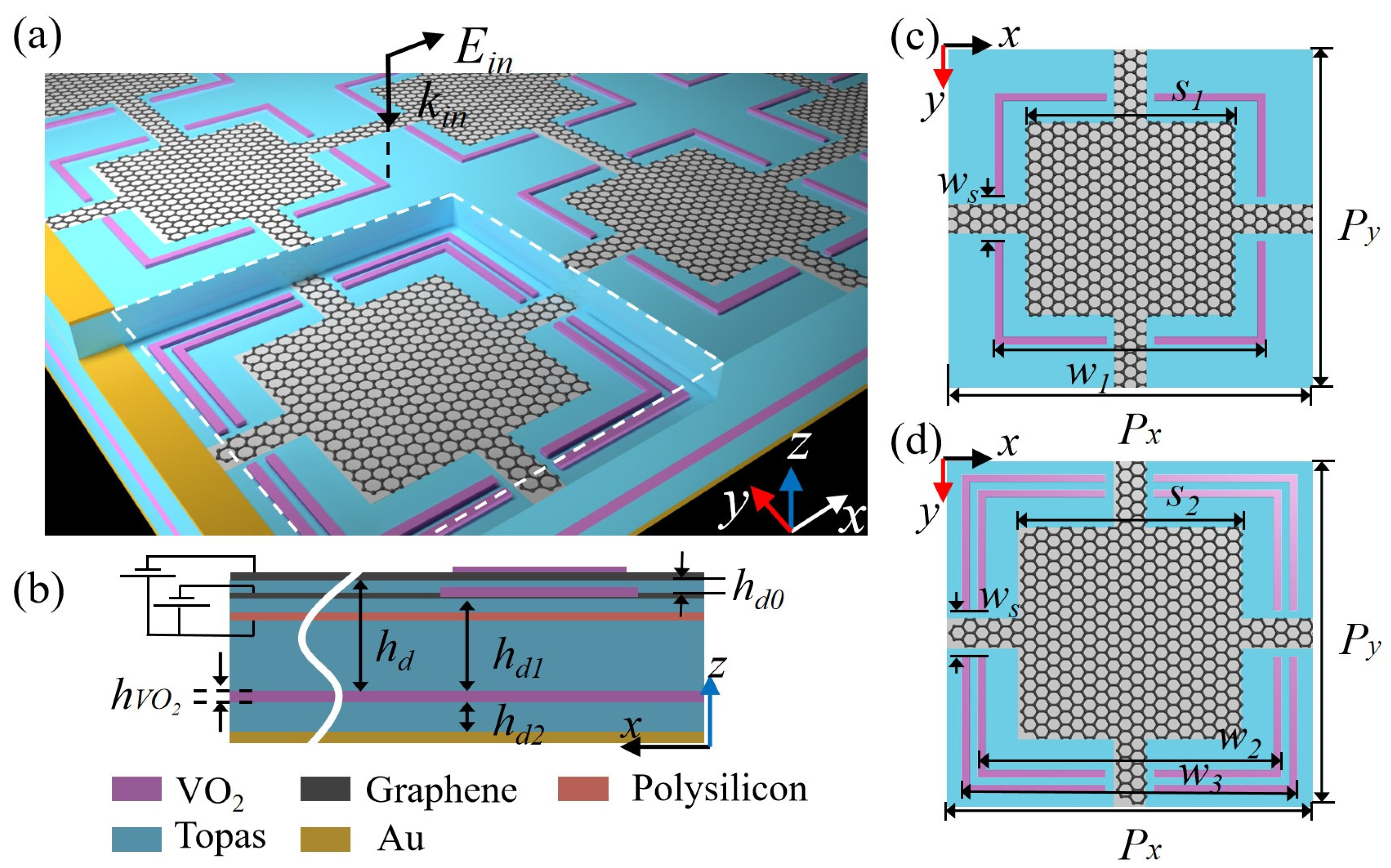


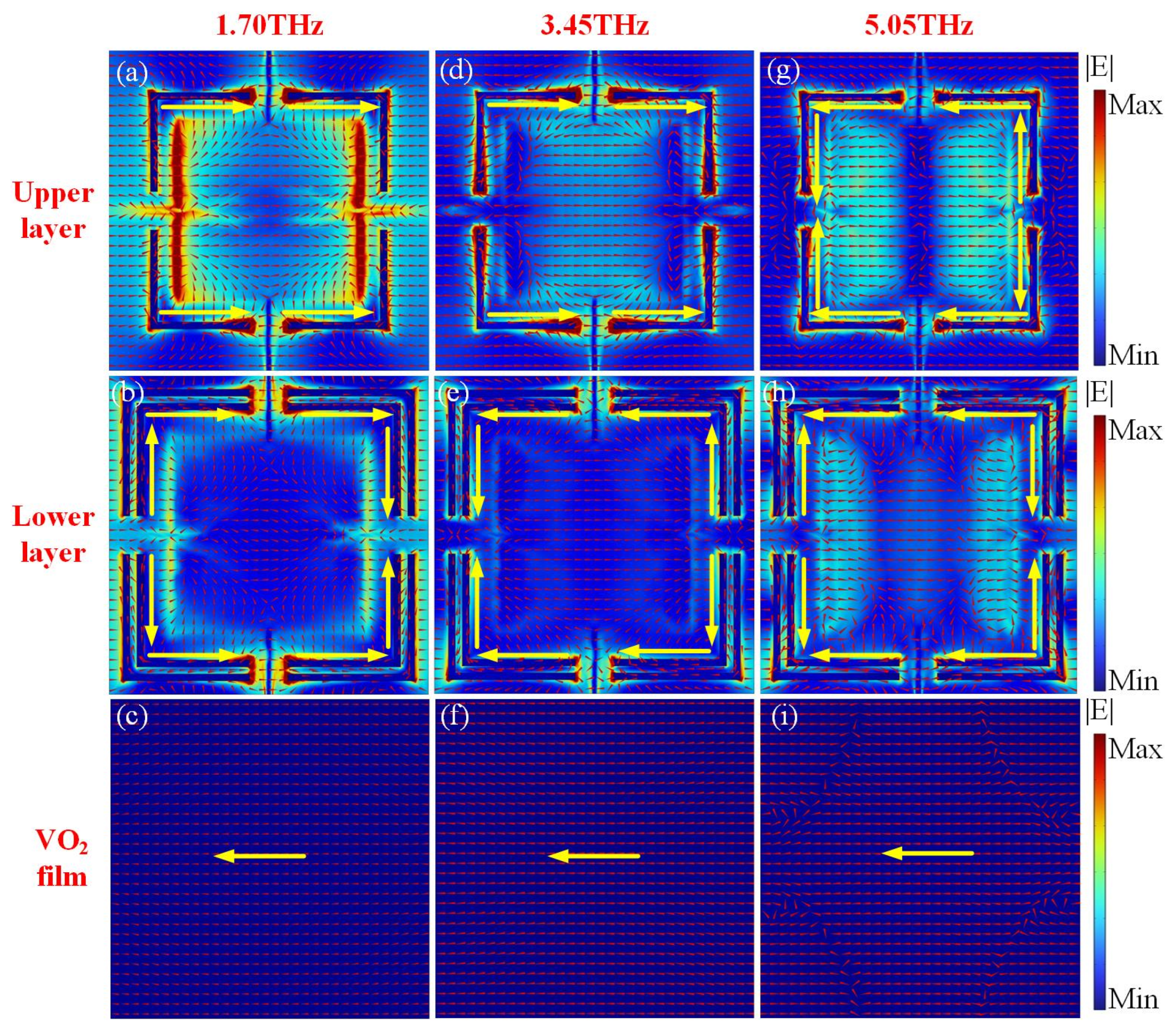

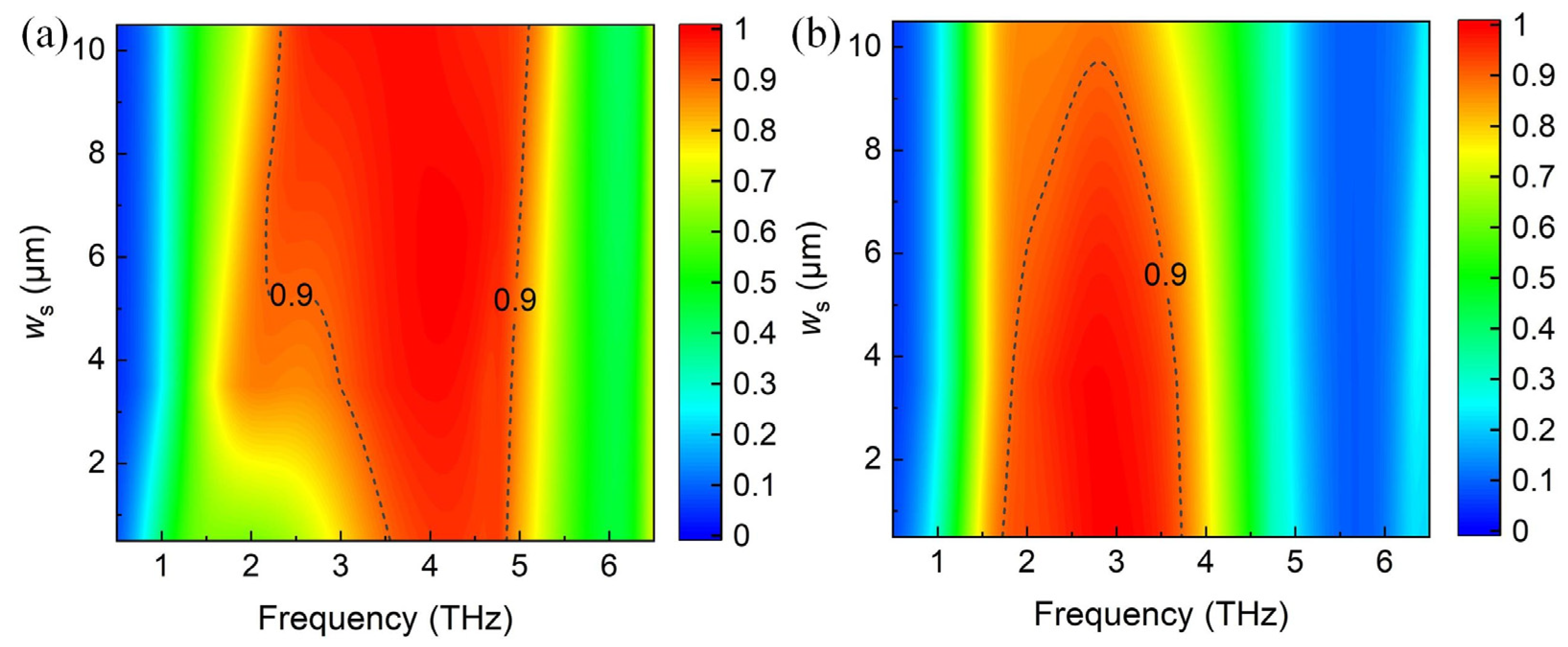
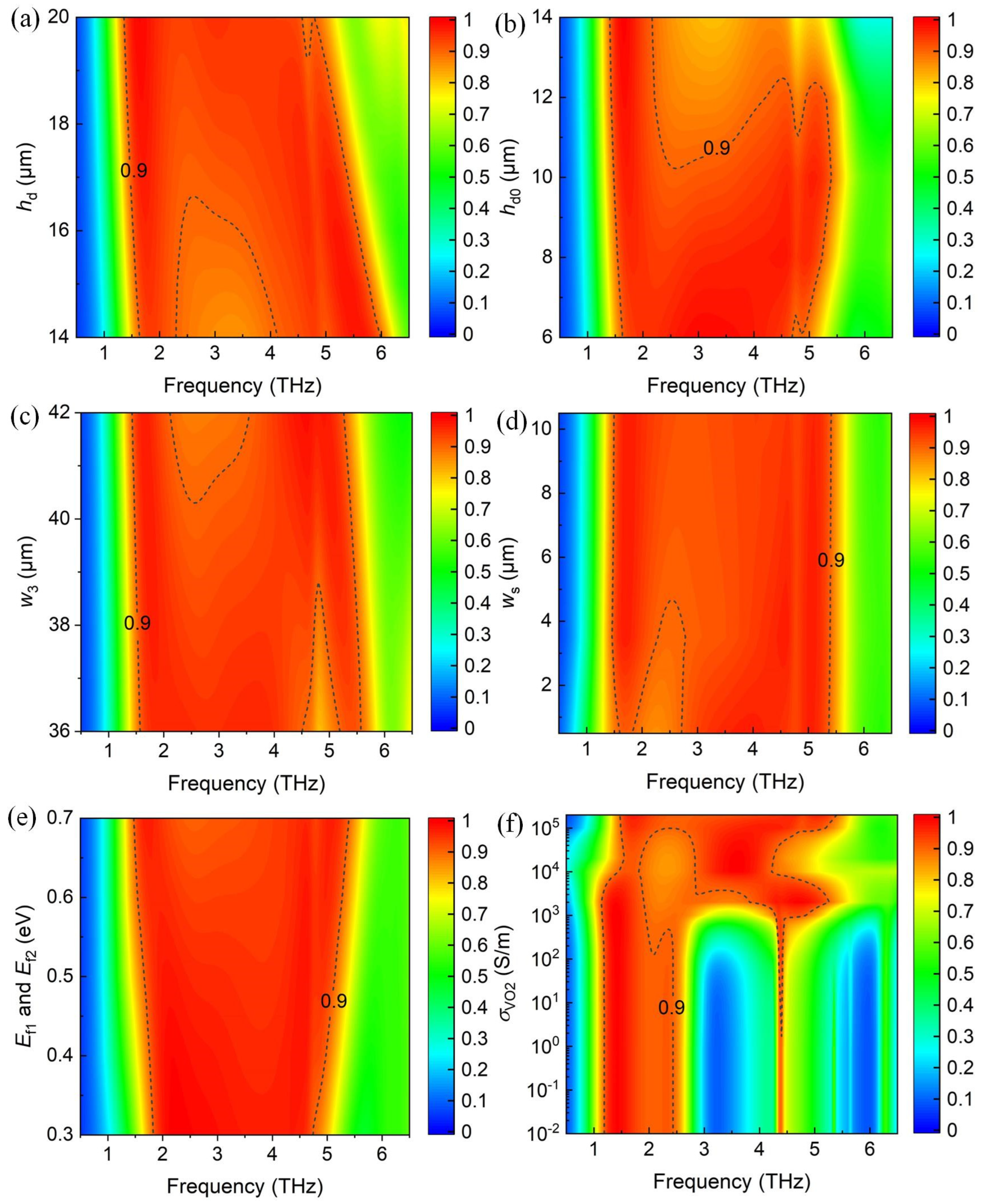

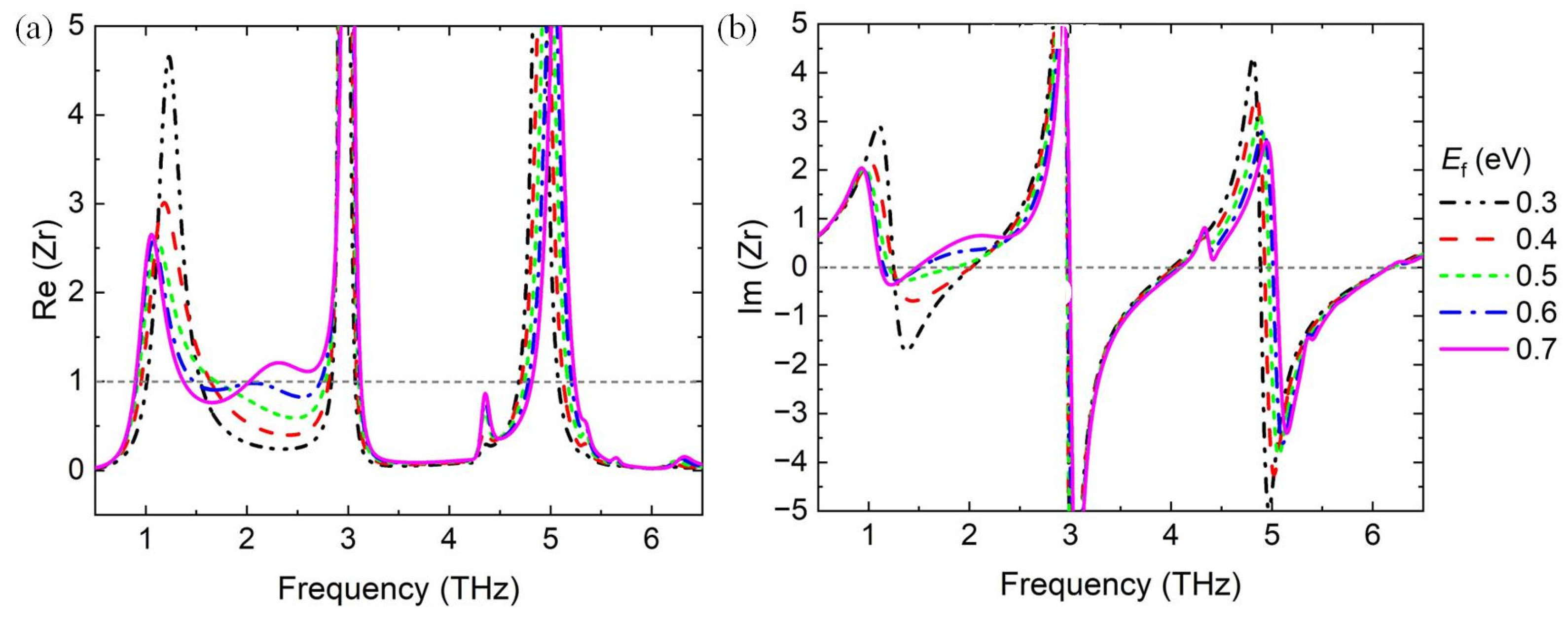
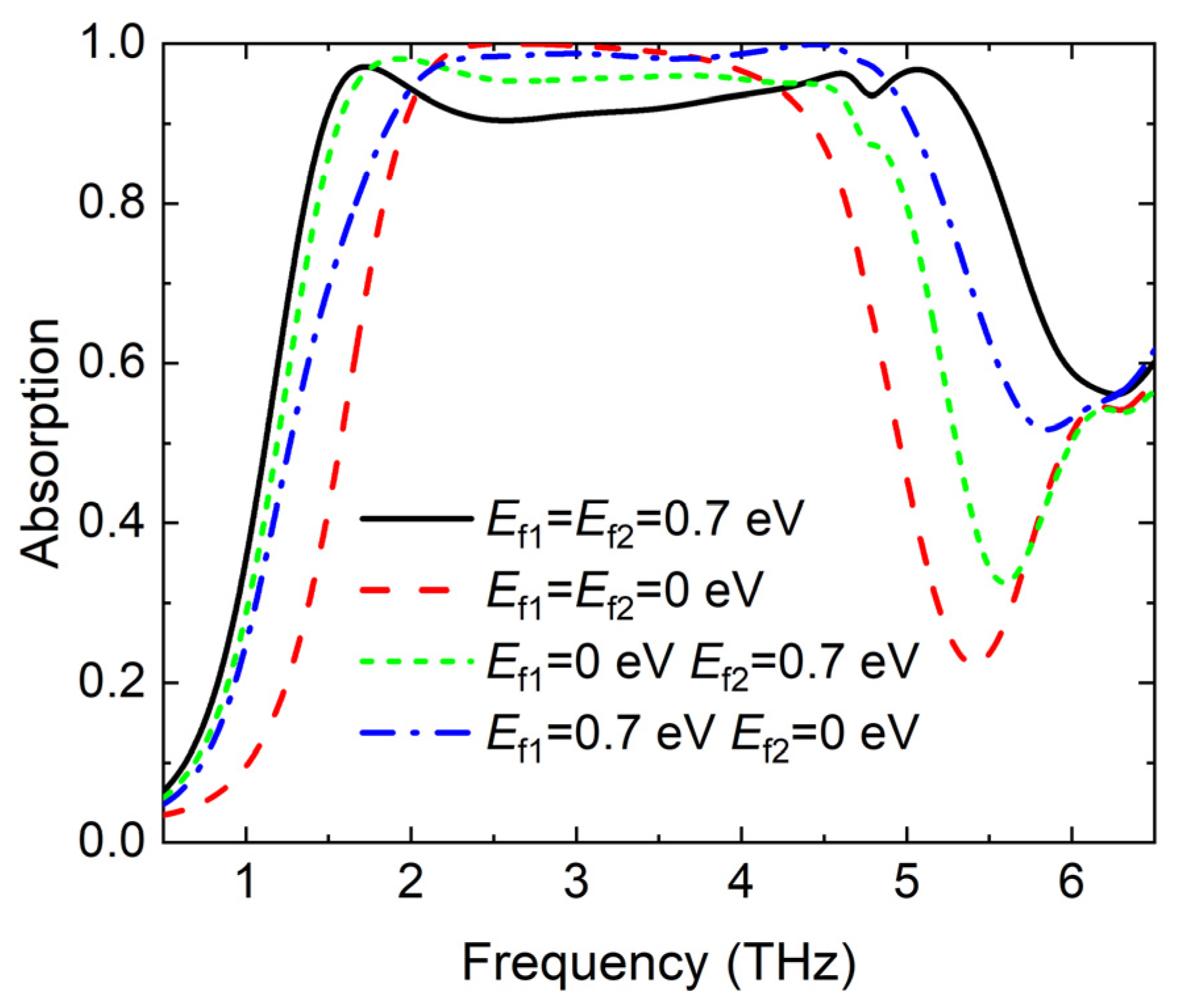
| Reference | Functionality | Switchable States | RB of Broadband | Active Materials | Tunning Method |
|---|---|---|---|---|---|
| [39] | Single- and dual-band absorption | 2 | \ | SrTiO3 and Dirac semimetal | Temperature and voltage |
| [40] | Broadband and narrowband | 2 | 111% | Graphene and VO2 | Temperature and voltage |
| [41] | Broadband and narrowband | 2 | 97.1% | Graphene and VO2 | Temperature and voltage |
| [42] | Single narrowband | 1 | \ | Graphene, SrTiO3 and VO2 | Temperature and voltage |
| [43] | Triple-band and broadband | 2 | 82.5% | VO2 | Temperature |
| [44] | Multiband (three peaks) and broadband | 2 | 122.6% | Graphene and VO2 | Temperature and voltage |
| [45] | Broadband and narrowband | 2 | 66.7% | Graphene | Voltage |
| This study | Broadband absorption with variable bandwidth | 5 | 113% | Graphene and VO2 | Temperature and voltage |
| Parameter | Description | Numerical Value |
|---|---|---|
| Px | Period of unit cell in the x-direction | 46 μm |
| Py | Period of unit cell in the y-direction | 46 μm |
| hd0 | Spacer of the two graphene layers | 7 μm |
| hd1 | Thickness of the upper Topas layer | 10 μm |
| hd2 | Thickness of the lower Topas layer | 8 μm |
| hVO2 | Thickness of the VO2 layer | 2 μm |
| ws | Gap of the VO2 split loops | 5.5 μm |
| w1 | Length of the VO2 split loops | 42 μm |
| w2 | 38 μm | |
| w3 | 34 μm | |
| s1 | Length of the graphene squares | 28 μm |
| s2 | 26 μm |
Disclaimer/Publisher’s Note: The statements, opinions and data contained in all publications are solely those of the individual author(s) and contributor(s) and not of MDPI and/or the editor(s). MDPI and/or the editor(s) disclaim responsibility for any injury to people or property resulting from any ideas, methods, instructions or products referred to in the content. |
© 2024 by the authors. Licensee MDPI, Basel, Switzerland. This article is an open access article distributed under the terms and conditions of the Creative Commons Attribution (CC BY) license (https://creativecommons.org/licenses/by/4.0/).
Share and Cite
Liu, Y.; Hu, L. A Metamaterials-Based Absorber Used for Switch Applications with Dynamically Variable Bandwidth in Terahertz Regime. Materials 2024, 17, 3571. https://doi.org/10.3390/ma17143571
Liu Y, Hu L. A Metamaterials-Based Absorber Used for Switch Applications with Dynamically Variable Bandwidth in Terahertz Regime. Materials. 2024; 17(14):3571. https://doi.org/10.3390/ma17143571
Chicago/Turabian StyleLiu, Yan, and Lingxi Hu. 2024. "A Metamaterials-Based Absorber Used for Switch Applications with Dynamically Variable Bandwidth in Terahertz Regime" Materials 17, no. 14: 3571. https://doi.org/10.3390/ma17143571




